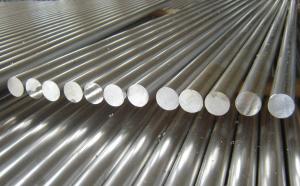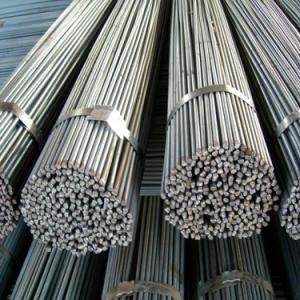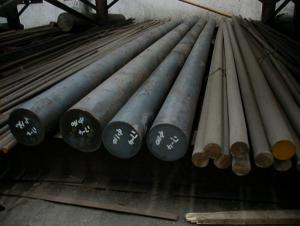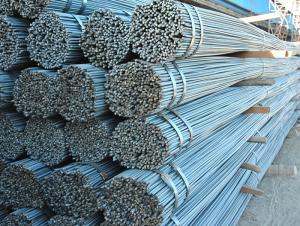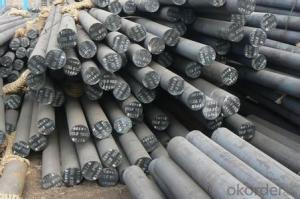Round Bar 5mm-10mm Hot Rolled High Quality Q195 Q235
- Loading Port:
- China Main Port
- Payment Terms:
- TT or LC
- Min Order Qty:
- -
- Supply Capability:
- -
OKorder Service Pledge
OKorder Financial Service
You Might Also Like
Product Description:
OKorder is offering high quality Hot Rolled Steel I-Beams at great prices with worldwide shipping. Our supplier is a world-class manufacturer of steel, with our products utilized the world over. OKorder annually supplies products to European, North American and Asian markets. We provide quotations within 24 hours of receiving an inquiry and guarantee competitive prices.
Product Applications:
Deformed bar is widely used in buildings, bridges, roads and other engineering construction. Big to highways, railways, bridges, culverts, tunnels, public facilities such as flood control, dam, small to housing construction, beam, column, wall and the foundation of the plate, deformed bar is an integral structure material. With the development of world economy and the vigorous development of infrastructure construction, real estate, the demand for deformed bar will be larger and larger
Product Advantages:
OKorder's Steel I-Beams are durable, strong, and resist corrosion, exact size, regular package, chemical and mechanical properties are stable.
Main Product Features:
· Premium quality
· Prompt delivery & seaworthy packing (30 days after receiving deposit)
· Corrosion resistance
· Can be recycled and reused
· Mill test certification
· Professional Service
· Competitive pricing
Product Specifications:
Manufacture: Hot rolled
Grade: BS4449
Certificates: ISO, SGS, BV, CIQ
Diameter: 6mm,8mm,10mm,12mm,14mm,16mm,18mm,20mm,
22mm,25mm,28mm,32mm,36mm,40mm,50mm
Length: 6M, 9M,12M or as required
Packaging: Export packing, nude packing, bundled
Chemical Composition: (Please kindly find our chemistry of our material based on HRB500 as below for your information)
Grade | Technical data of the original chemical composition (%) | ||||||
C | Mn | Si | S | P | V | ||
HRB400 | ≤0.25 | ≤1.60 | ≤0.80 | ≤0.045 | ≤0.045 | 0.04-0.12 | |
Physical capability | |||||||
Yield Strength (N/cm²) | Tensile Strength (N/cm²) | Elongation (%) | |||||
≥400 | ≥570 | ≥14 | |||||
Theoretical weight and section area of each diameter as below for your information:
Diameter(mm) | Section area (mm²) | Mass(kg/m) | Weight of 12m bar(kg) |
6 | 28.27 | 0.222 | 2.664 |
8 | 50.27 | 0.395 | 4.74 |
10 | 78.54 | 0.617 | 7.404 |
12 | 113.1 | 0.888 | 10.656 |
14 | 153.9 | 1.21 | 14.52 |
16 | 201.1 | 1.58 | 18.96 |
18 | 254.5 | 2.00 | 24 |
20 | 314.2 | 2.47 | 29.64 |
22 | 380.1 | 2.98 | 35.76 |
25 | 490.9 | 3.85 | 46.2 |
28 | 615.8 | 4.83 | 57.96 |
32 | 804.2 | 6.31 | 75.72 |
36 | 1018 | 7.99 | 98.88 |
40 | 1257 | 9.87 | 118.44 |
50 | 1964 | 15.42 | 185.04 |
FAQ:
Q1: Why buy Materials & Equipment from OKorder.com?
A1: All products offered byOKorder.com are carefully selected from China's most reliable manufacturing enterprises. Through its ISO certifications, OKorder.com adheres to the highest standards and a commitment to supply chain safety and customer satisfaction.
Q2: What makes stainless steel stainless?
A2: Stainless steel must contain at least 10.5 % chromium. It is this element that reacts with the oxygen in the air to form a complex chrome-oxide surface layer that is invisible but strong enough to prevent further oxygen from "staining" (rusting) the surface. Higher levels of chromium and the addition of other alloying elements such as nickel and molybdenum enhance this surface layer and improve the corrosion resistance of the stainless material.
Q3: Can stainless steel rust?
A3: Stainless does not "rust" as you think of regular steel rusting with a red oxide on the surface that flakes off. If you see red rust it is probably due to some iron particles that have contaminated the surface of the stainless steel and it is these iron particles that are rusting. Look at the source of the rusting and see if you can remove it from the surface.

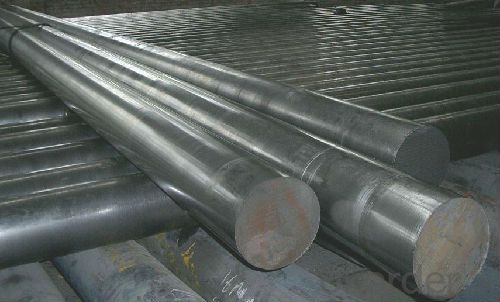
- Q:Can steel round bars be used for making bearings?
- Steel round bars can indeed be used for making bearings. However, it is important to note that the specific type of steel used, as well as the manufacturing process, play a crucial role in determining the suitability of steel round bars for bearing applications. Bearings are typically subjected to high loads and require good wear resistance, low friction, and high durability. Steel round bars made from high-quality alloy steels, such as chrome steel or stainless steel, are commonly used for bearing manufacturing due to their excellent mechanical properties. These steel round bars undergo specific heat treatment processes, such as quenching and tempering, to enhance their hardness, strength, and wear resistance. Additionally, the round bars are typically machined to precise tolerances to ensure proper fit and alignment within the bearing assembly. It is important to consult with materials and manufacturing experts or refer to industry standards to ensure the appropriate steel round bar material and manufacturing processes are used for bearing applications. This will ensure the best performance, reliability, and longevity of the bearings in various operating conditions.
- Q:How are steel round bars used in the construction of offshore structures?
- Steel round bars are commonly used in the construction of offshore structures due to their high strength and durability. These bars are typically made from carbon steel or alloy steel, which are known for their excellent mechanical properties. In offshore construction, steel round bars are primarily used to provide structural support and reinforcement. They are used in various applications, such as the construction of oil rigs, offshore platforms, pipelines, and subsea structures. One of the key uses of steel round bars is in the fabrication of piles. Piles are long, cylindrical structures that are driven into the seabed to provide a stable foundation for offshore structures. These piles are typically made from steel round bars due to their ability to withstand the harsh marine environment and high loads. Steel round bars are also used in the construction of offshore platforms. These platforms are large, elevated structures that provide a workspace for oil and gas exploration and production activities. The steel round bars are used to create the framework of the platform, forming the main structural elements such as columns, beams, and trusses. These bars are often welded or bolted together to create a strong and rigid structure capable of withstanding extreme weather conditions and heavy loads. Furthermore, steel round bars are utilized in the construction of pipelines that transport oil and gas from offshore wells to onshore facilities. These bars are used to create the pipeline supports, ensuring that the pipeline remains stable and securely fastened to the seabed. In conclusion, steel round bars play a vital role in the construction of offshore structures. Their high strength, durability, and ability to withstand harsh marine environments make them an ideal choice for providing structural support and reinforcement in offshore construction projects.
- Q:Are steel round bars susceptible to rust?
- Steel round bars are indeed susceptible to rust. Rust is the result of a chemical reaction between iron and oxygen in the presence of moisture. Since steel is primarily made of iron, it can rust when exposed to air and moisture. However, the susceptibility to rust can be reduced by taking certain preventive measures. Steel round bars can be coated with protective layers such as paint, oil, or galvanized coatings to create a barrier between the steel and the surrounding environment, thus preventing or delaying the onset of rust. Regular maintenance, including cleaning and reapplying protective coatings, can further help in minimizing the risk of rust formation on steel round bars.
- Q:Can steel round bars be used for decorative purposes?
- Indeed, decorative purposes can be served by steel round bars. When utilized in diverse architectural and interior design ventures, they contribute a contemporary and industrial appeal. By shaping, bending, and welding steel round bars, one can fashion exclusive and attention-grabbing items like furniture, sculptures, railings, and decorative accents. Their polished and metallic look harmonizes with various styles and design motifs, rendering them a versatile option for embellishment. Moreover, the durability and longevity of steel round bars guarantee that these decorative elements will endure the passage of time.
- Q:What is the difference between a bright and a rough turned steel round bar?
- A bright turned steel round bar refers to a steel bar that has undergone a finishing process, resulting in a smooth and polished surface. On the other hand, a rough turned steel round bar has a more textured surface due to minimal finishing, giving it a rougher appearance.
- Q:How are steel round bars used in the oil and gas industry?
- Steel round bars are widely used in the oil and gas industry for various applications. One of the main uses of steel round bars is in drilling operations. They are used to manufacture drill bits and drill collars, which are essential components of drilling equipment. These drill bits and collars are subjected to high levels of stress and wear during drilling, and steel round bars provide the necessary strength and durability to withstand these conditions. Additionally, steel round bars are used in the construction of oil and gas pipelines. These pipelines are used for the transportation of crude oil, natural gas, and other petroleum products over long distances. Steel round bars are used to manufacture the pipes, ensuring that they have the necessary strength and resistance to corrosion to withstand the harsh operating conditions. Steel round bars also find applications in the construction of oil and gas storage tanks and pressure vessels. These tanks and vessels are used to store and transport petroleum products and gases under high pressure. Steel round bars provide the required structural integrity and strength to ensure the safe storage and transportation of these substances. Furthermore, steel round bars are used in the fabrication of various other equipment used in the oil and gas industry, such as valves, fittings, pumps, and compressors. These components are crucial for the efficient and safe operation of oil and gas production facilities. In summary, steel round bars play a vital role in the oil and gas industry. They are used in drilling operations, pipeline construction, storage tank fabrication, and the manufacturing of various equipment. Their strength, durability, and resistance to corrosion make them ideal for these demanding applications, ensuring the efficient and safe extraction, transportation, and storage of oil and gas.
- Q:Can steel round bars be used in the production of agricultural equipment?
- Yes, steel round bars can be used in the production of agricultural equipment. Steel round bars are known for their strength, durability, and versatility, making them suitable for various applications, including agricultural equipment manufacturing. They can be used for constructing frames, supports, axles, and other components that require high strength and resistance to wear and tear.
- Q:How are steel round bars measured?
- Steel round bars are measured by their diameter, which is typically specified in millimeters or inches. The measurement is taken by using a caliper or a micrometer at various points along the bar, ensuring accuracy and consistency.
- Q:What are the different surface finishes available for steel round bars?
- There are several surface finishes available for steel round bars, each offering unique properties and applications. Some of the common surface finishes include: 1. Hot Rolled: This is the most basic surface finish, achieved by heating the steel above its recrystallization temperature and then allowing it to cool. It provides a rough and scaled surface, ideal for applications that do not require a high level of aesthetics. 2. Cold Drawn: In this process, the steel round bar is pulled through a die at room temperature, resulting in a smooth and polished surface. Cold drawn surface finish offers improved dimensional accuracy and tighter tolerances, making it suitable for applications that require precision and a visually appealing appearance. 3. Turned and Polished: Steel round bars can be turned on a lathe machine to achieve a smooth and shiny surface finish. This process removes any imperfections and irregularities, providing a close tolerance and highly finished surface. Turned and polished bars are often used in applications where a high level of surface finish and dimensional accuracy is required, such as in the manufacturing of shafts and precision components. 4. Ground: Steel round bars can be ground to remove any surface defects or irregularities. Grinding produces a highly accurate and smooth surface finish, making it suitable for applications that require close tolerances and a superior surface finish. Ground bars are commonly used in the manufacturing of bearings, gears, and other high-precision components. 5. Coated: Steel round bars can also be coated with various materials to enhance their performance and protect them from corrosion. Common coating options include zinc, chrome, and nickel. Coated bars offer improved durability, resistance to corrosion, and enhanced aesthetic appeal. The choice of surface finish for steel round bars depends on the specific requirements of the application, such as dimensional accuracy, surface quality, corrosion resistance, and aesthetic appeal.
- Q:What are the different grades of steel round bars?
- There are several different grades of steel round bars, each with its own unique properties and characteristics. Some of the most common grades include: 1. Mild Steel: Also known as low carbon steel, this grade is the most widely used due to its affordability and versatility. It has a relatively low carbon content and is easy to weld and form. 2. Carbon Steel: This grade contains a higher carbon content than mild steel, making it stronger and more durable. It is commonly used in applications that require high strength and hardness, such as construction and machinery. 3. Alloy Steel: Alloy steel round bars are made by combining different elements, such as chromium, nickel, or molybdenum, with carbon steel. This creates a material with enhanced properties, such as increased corrosion resistance, improved toughness, and higher tensile strength. 4. Stainless Steel: Stainless steel round bars are made primarily from iron and contain a minimum of 10.5% chromium. This grade of steel is known for its excellent corrosion resistance and is commonly used in applications where hygiene and cleanliness are crucial, such as in the food and pharmaceutical industries. 5. Tool Steel: Tool steel round bars are specifically designed to withstand high temperatures, heavy loads, and repeated impacts. They have excellent hardness, wear resistance, and toughness, making them suitable for manufacturing tools and dies. 6. High-Speed Steel (HSS): HSS round bars are a type of tool steel that can withstand high cutting speeds without losing their hardness. They are commonly used in applications that involve cutting, drilling, or machining at high speeds, such as in the manufacturing of drills and milling cutters. These are just a few of the many grades of steel round bars available, each designed to meet specific requirements in various industries and applications. It is important to select the appropriate grade based on factors such as strength, corrosion resistance, and desired properties for a particular project or usage.
1. Manufacturer Overview |
|
|---|---|
| Location | |
| Year Established | |
| Annual Output Value | |
| Main Markets | |
| Company Certifications | |
2. Manufacturer Certificates |
|
|---|---|
| a) Certification Name | |
| Range | |
| Reference | |
| Validity Period | |
3. Manufacturer Capability |
|
|---|---|
| a)Trade Capacity | |
| Nearest Port | |
| Export Percentage | |
| No.of Employees in Trade Department | |
| Language Spoken: | |
| b)Factory Information | |
| Factory Size: | |
| No. of Production Lines | |
| Contract Manufacturing | |
| Product Price Range | |
Send your message to us
Round Bar 5mm-10mm Hot Rolled High Quality Q195 Q235
- Loading Port:
- China Main Port
- Payment Terms:
- TT or LC
- Min Order Qty:
- -
- Supply Capability:
- -
OKorder Service Pledge
OKorder Financial Service
Similar products
New products
Hot products
Related keywords
